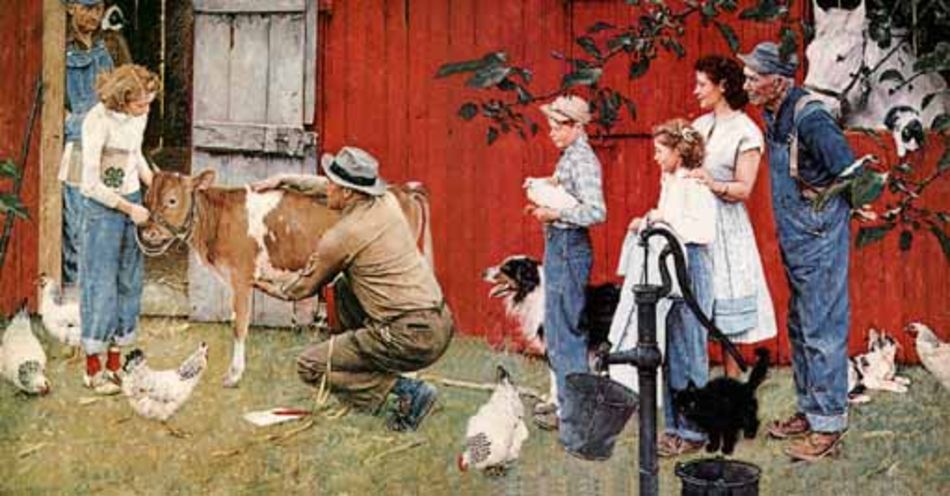 Introduction:
Introduction:
While most people recognize the Hatch Act as starting agricultural experiment stations, which it did, it also called for the dissemination of agricultural knowledge. So, how does one do this?
At the time the Hatch Act was passed in 1887 numerous land grant colleges were being criticized for not meeting the needs of the farmers. In an effort to reach the farmers with agricultural information Agricultural Institutes were started. An Agricultural Institute was a “road show” of agriculturalists who traveled from community to community putting on education programs for farmers. Land grant colleges, state agricultural societies, and state boards of agriculture all sponsored Farmers Institutes.
The Farmer’s Institutes also sponsored Boy’s Corn Clubs. This was followed by Girl’s Tomato and Canning Clubs. It was not long before 4-H and the Cooperative Extension Service came into existence. In this lesson, we will learn about the various efforts to disseminate agricultural knowledge that was initially started by the Hatch Act
 Lesson Objectives:
Lesson Objectives:
At the completion of the lesson you should be able to:
- Describe the operation of Farmer’s Institutes.
- Explain what demonstration trains were.
- Describe the operation of Boy’s Corn Clubs and Girl’s Tomato Clubs
- Explain early developments leading to the formation of the Cooperative Extension Service.
- Recognize the contributions of Seaman Knapp to the development of extension work.
- Describe modern-day extension.
 Assignment:
Assignment:
Assume it is 1909. A Farmer’s Institute is coming to your community. Go to the list of Institute Speakers and select the one you would like to hear. Explain why you selected that particular speaker. You will be asked to share this in class.
![]() The PowerPoint Presentation Used with the Lesson (in PDF format)
The PowerPoint Presentation Used with the Lesson (in PDF format)
A pdf file with the PowerPoint Presentation used in this lesson can be viewed here.
 Additional Resources for Enrichment Purposes:
Additional Resources for Enrichment Purposes:
I publish a weekly blog called the Friday Footnote. A number of the topics discussed in this lesson have been featured in a Friday Footnote. You might want to read them:
- Farmers Institutes – an overview of Farmers Institutes
- I Hear the Train a Comin – describes the Farmers Institutes that traveled by train
- Boy’s Corn Clubs – tells how the corn clubs got started
- Girl’s Tomato and Canning Clubs – tells how the girls tomato clubs started
- Celebrating 100 Years of the American Farm Bureau Federation – Would you believe the Cooperative Extension Service got started as a part of the Farm Bureau
- The Farm Bureau and the Extension Service Divorce – looks at the separation of the two organizations
Read this short article about “Farmers’ Institutes and Their Work” written by an individual who was involved in Farmers’ Institute Work.
John Hamilton was employed by the USDA Office of Experiment Stations to lead the Farmers’ Institute work. In 1904 (soon after he was employed) he wrote this booklet about the status of the work. You might look at some of the tables in the back to see the status of the work in your state.
Jane McKimmon was in charge of the Girl’s tomato clubs in NC. If this class was being taught live we would be meeting in the McKimmon Center on campus. Click here to learn more this early pioneer in Extension. Just about every state had their own Jane McKimmon.
View several excellent videos about the Cooperative Extension Service.
- Introducing University of Missouri Extension (and who says Missourians have no sense of humor – this video, while focused on UM, is applicable to all states)
- A Typical Day for an Extension Agent (from K-State)
- Penn State Cooperative Extension (it should be obvious where this is from)
- North Carolina Cooperative Extension: Knowledge is Power (home cooking here)
Visit the North Carolina State University Extension Web Site.
In 2014 UNC-TV produced a video about the history of extension in North Carolina.
So what is the new kid on the block – eXtension?
So what is the impact of Extension? Here is a video with that information from Missouri. See a video of some Extension activities in Kansas.
And finally, the television show “Green Acres” had a character named Mr. Kimball. He was the county agent. He was portrayed as an incompetent nincompoop. Click here to see a video of Mr. Kimball in action. This doesn’t really represent Extension but is good for a chuckle.
